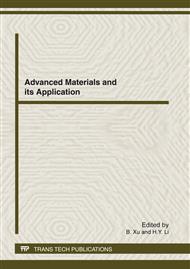p.342
p.347
p.351
p.356
p.361
p.365
p.368
p.372
p.376
Application Property and Structural Characteristics of Bark Lignosulfonate Superplasticiser
Abstract:
The application property and structural characteristics of bark lignosulfonate (LS) was studied. Results showed that bark LS had perfect application property in concrete. The fluidity of cement paste was 214mm, which was 87.0% of commercial superplasticiser of naphthalene sulfonate; the loss on fluidity of cement paste of bark LS was very small, which was much better than that of naphthalene sulfonate. The loss on fluidity of cement paste of bark LS after 60 min was only 5.6%, but that of naphthalene sulfonate was 30.6%. Bark LS had low foaming capacity and high foam stability. Surface tension of 1% bark LS solution was 48.1 mN/m. Structural characteristics of bark LS was also studied. It showed that the reason that bark LS had good application property was that it had high content of hydrophilic sulfonic group, carboxyl group and phenolic hydroxyl group, and uniform molecular weight distribution.
Info:
Periodical:
Pages:
361-364
Citation:
Online since:
February 2012
Authors:
Keywords:
Price:
Сopyright:
© 2012 Trans Tech Publications Ltd. All Rights Reserved
Share:
Citation:


